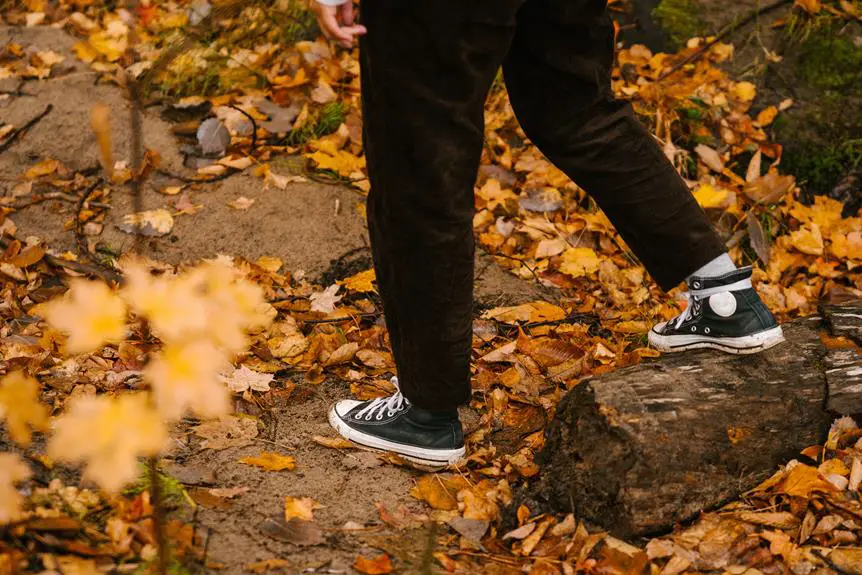Looking to master the art of dyeing your pants black? You've come to the right place.
In this guide, you'll discover 10 easy and effective methods to achieve perfectly dyed black pants. From using black fabric dye and the boiling method to cold water dye and vegetable dyeing, you'll have a variety of techniques at your disposal.
Whether you prefer the dip dye technique or opt for black fabric paint, these methods will help you achieve the black pants of your dreams.
So, let's dive into the world of dyeing and transform your pants with these expert techniques.
Key Takeaways
- Using black fabric dye and the boiling method are effective ways to dye pants black.
- Cold water dyeing is another option to consider for dyeing pants black.
- When dyeing pants, it is important to avoid color patchiness and consider the fabric type.
- Natural dye alternatives such as tea or coffee dyeing and natural indigo dye can be used to achieve a black color on pants.
Using Black Fabric Dye
To dye your pants black using black fabric dye, you'll need to gather the necessary materials and prepare a suitable dyeing space. Start by selecting a high-quality black fabric dye that's suitable for the type of fabric your pants are made of.
Additionally, gather a stainless steel pot, hot water, rubber gloves, and a stirring utensil. Before beginning the dyeing process, it's crucial to prepare the fabric by washing it to remove any dirt, oils, or finishes that could interfere with the dye's absorption. Once the fabric is clean and damp, it's ready for the dye application.
When applying the black fabric dye, ensure that the dye is mixed thoroughly and the water is at the appropriate temperature as per the dye's instructions. Submerge the pants in the dye bath and stir continuously to ensure an even distribution of color. For a solid black color, the pants may need to be in the dye bath for an extended period.
After dyeing, rinse the pants with cold water, then wash and dry them according to the dye instructions to set the color. These fabric preparation and dye application techniques will help you achieve a professional-looking black dye on your pants.
Boiling Method
When using the boiling method to dye your pants black, you'll need to ensure that the fabric is fully submerged to achieve a uniform color. This method also helps to avoid any patchiness in the final result.
It's important to consider the type of fabric you're working with, as different materials may require different boiling times.
Boiling for Uniform Color
For even and consistent black dyeing of your pants, boil the fabric in a large pot of black dye solution. The boiling technique ensures uniform coloration by allowing the fabric to absorb the dye evenly.
Start by preparing a large pot of water and adding the black fabric dye according to the package instructions. Submerge the pants in the dye solution and bring it to a boil. Let the fabric boil for about 30-60 minutes, stirring occasionally to ensure that the dye is distributed evenly.
Keep in mind that the boiling time may vary based on the fabric type and the dye used, so it's important to refer to the dye package for specific instructions.
Once the desired color is achieved, remove the pants from the dye solution and rinse them thoroughly with cold water.
Avoid Color Patchiness
To prevent color patchiness when boiling your pants in black dye, carefully monitor the boiling process and stir the fabric regularly to ensure even color distribution.
Color blending is crucial to avoiding patchwork patterns. The key is to maintain a consistent temperature throughout the boiling process. This allows the dye to penetrate the fabric evenly, preventing any patchiness.
Stirring the pants regularly helps to disperse the dye and avoid concentrated areas of color. Additionally, consider pre-soaking the pants in a water and dye mixture before boiling to promote uniform color absorption.
Be attentive to any signs of patchiness during the boiling process and make adjustments as necessary. By following these steps, you can achieve a beautifully dyed pair of pants without any color inconsistencies.
Consider Fabric Type
Consider the fabric type of your pants when boiling them in black dye to ensure the best results. Polyester blends and silk options require special attention when dyeing.
Polyester blends can be dyed using a boiling method, but the temperature should be carefully controlled to prevent damage to the fabric. Boil the pants in the black dye for the recommended time, and then rinse them thoroughly with cold water to set the color.
Silk options also need to be treated with care. When boiling silk pants in black dye, use a mild detergent and avoid excessive agitation to prevent damage to the delicate fibers. Once dyed, gently rinse the pants in cold water and air dry them to maintain the fabric's integrity and the rich black color.
Cold Water Dye
When it comes to cold water dyeing, it's important to understand the process and the best fabrics for dye.
Cold water dyeing involves using a dye that sets at lower temperatures, making it suitable for delicate fabrics.
Understanding which fabrics work best for cold water dyeing can help you achieve the desired results without damaging your pants.
Cold Water Dyeing Process
You can achieve a deep black color on your pants by using a cold water dyeing process. Unlike traditional dyeing methods, cold water dye offers quick results without the need for hot water or constant monitoring. The process minimizes mess and simplifies the dyeing experience, making it an ideal choice for beginners and those looking for a hassle-free dyeing process.
Here's why cold water dyeing process is a great choice:
- Speed: Achieve vibrant black pants in a fraction of the time it takes with traditional dyeing methods.
- Cleanliness: Minimize the mess typically associated with dyeing, as cold water dyeing eliminates the need for hot water and constant stirring.
- Ease of Use: Simplify the dyeing process and achieve professional results with minimal effort.
Best Fabrics for Dye
For best results with the cold water dyeing process, opt for fabrics such as cotton, linen, or rayon to achieve a rich, even black color on your pants. These fabrics readily absorb dye and hold onto the color well, resulting in a vibrant and long-lasting hue. When dyeing pants, it's essential to choose fabrics that are receptive to the dye and have good color fastness to prevent fading over time. The table below outlines the best fabrics for dyeing pants black using the cold water dyeing technique.
| Fabric | Dyeing Technique | Color Fastness | Dye Application |
|---|---|---|---|
| Cotton | Cold Water | High | Evenly saturate |
| Linen | Cold Water | High | Evenly saturate |
| Rayon | Cold Water | High | Evenly saturate |
Vegetable Dyeing
To dye pants black using vegetable dye, start by preparing the fabric for dyeing. Wash and rinse the pants to remove any dirt, stains, or sizing that may interfere with the dyeing process.
Then, mordant the fabric by soaking it in a solution of water and mordant, such as alum, to help the dye adhere better and improve colorfastness.
Vegetable dyeing offers a natural and eco-friendly alternative to synthetic dyes. By using DIY techniques, you can achieve a sense of mastery and fulfillment in creating a unique black hue for your pants. Embrace the cultural and historical significance of vegetable dyeing while contributing to sustainable and environmentally conscious practices.
Tea or Coffee Dye
Looking for natural alternatives to conventional fabric dyes? Tea or coffee dyeing might be the solution you're looking for.
These methods offer a simple and straightforward way to dye your pants black, with the added bonus of creating unique color variations on different fabrics.
Whether you prefer tea or coffee, the dyeing process is relatively easy and can produce beautiful, natural results.
Natural Dye Alternatives
Consider using tea or coffee to dye your pants black for a natural and eco-friendly alternative.
- Rich and Earthy Tones: Tea or coffee dyeing produces deep, rich tones that can give your pants a unique and vintage look.
- Eco-Friendly Option: Opting for tea or coffee dye is an environmentally friendly choice, as it reduces the use of harsh chemicals and synthetic dyes.
- Versatile Application: Tea or coffee dyeing can be applied using the boiling method, which is a quick and easy way to achieve a black hue. Additionally, vegetable dyeing allows you to experiment with various natural ingredients for different shades of black.
Using tea or coffee to dye your pants is a sustainable and creative way to achieve a black color while minimizing the impact on the environment.
Dyeing Process Simplicity
You can easily achieve a black dye for your pants using tea or coffee, providing a simple and eco-friendly dyeing process. These DIY black dye alternatives offer eco-friendly options, allowing you to transform your pants without harsh chemicals. However, it's important to consider color fastness testing and dyeing longevity to ensure that your black pants stay vibrant wash after wash.
| Consideration | Description | Importance |
|---|---|---|
| Color fastness testing | Assess the dye's resistance to fading | Essential |
| Dyeing longevity | Evaluate the dye's staying power | Crucial |
Fabric Color Variations
To achieve fabric color variations using tea or coffee dye, follow these steps:
- Understand Color Fastness: Before dyeing with tea or coffee, it's crucial to assess the fabric's color fastness. Some fabrics may not hold the color well, leading to uneven or temporary results.
- Explore Fabric Color Theory: Delve into the basics of fabric color theory to predict how the dye will interact with the fabric's original color. This understanding will help you achieve the desired fabric color variations.
- Test and Adjust: Always conduct a test on a small fabric scrap first to observe how the dye interacts with the fabric. Adjust the concentration and duration of the dye bath as needed to achieve the desired fabric color variations.
Understanding color fastness and fabric color theory will ensure successful and lasting fabric color variations when using tea or coffee dye.
Natural Indigo Dye
When dyeing pants black with natural indigo dye, start by preparing the dye solution according to the instructions on the packaging. Natural indigo dye is one of the most eco-friendly dyeing options available, as it is derived from the plant Indigofera tinctoria and does not contain harmful chemicals. The process of dyeing with natural indigo dye requires careful preparation to ensure optimal results. Below is a table outlining the basic steps for dyeing pants black with natural indigo dye.
| Step | Description |
|---|---|
| 1. | Prepare the natural indigo dye solution according to the instructions provided. |
| 2. | Pre-wash the pants to remove any dirt or sizing that may interfere with the dye absorption. |
| 3. | Immerse the pre-washed pants in the dye bath and allow them to soak for the recommended time. |
| 4. | Rinse the pants thoroughly with cold water and let them air dry to reveal the rich black color. |
Following these steps will help you achieve a deep, long-lasting black hue on your pants using natural indigo dye, promoting both sustainability and style.
Black Rit Dye
Using Black Rit Dye, achieve a deep black color on your pants by following these simple steps.
- Prepare the Dye Solution:
Dissolve one packet of Black Rit Dye in a gallon of hot water. Stir the mixture well until the dye is completely dissolved. For a more eco-friendly option, consider using natural dye alternatives such as logwood or cutch, which produce deep black hues and are derived from sustainable plant sources.
- Prep Your Pants:
Wet your pants thoroughly and wring out any excess water. This will help the fabric absorb the dye evenly. For an eco-friendly approach, consider using organic cotton pants or other natural fiber materials that readily accept dyes and are biodegradable at the end of their lifecycle.
- Dye Your Pants:
Submerge your wet pants into the dye solution and stir continuously for about 30 minutes. For a sustainable twist, explore eco-friendly dye options like plant-based indigo or madder root dyes, which provide rich black colors while minimizing environmental impact.
Spray-On Fabric Dye
Consider using spray-on fabric dye for quick and easy black pants transformation. Spray-on fabric dye offers a convenient and efficient way to achieve a deep black color on your pants. The spray on application allows for even coverage and precise targeting of specific areas, giving you more control over the dyeing process.
Before applying the dye, it's important to conduct colorfastness testing on a small, inconspicuous area of the pants to ensure that the dye adheres properly and produces the desired color. Once the colorfastness testing is complete and the dye is ready to be applied, follow the instructions on the dye product carefully to achieve the best results.
When using spray-on fabric dye, it's crucial to work in a well-ventilated area and protect surrounding surfaces from potential overspray. Additionally, consider wearing protective gloves and clothing to prevent skin contact with the dye.
Black Fabric Paint
You can also achieve a black color transformation on your pants by using black fabric paint. Black fabric paint provides a quick and easy way to customize your pants and stay on top of DIY fashion trends.
Here are three key benefits of using black fabric paint for fabric customization:
- Versatility: Black fabric paint can be used to create a variety of designs and patterns on your pants, allowing for a high level of customization. Whether you want to add intricate details or go for a more minimalist approach, black fabric paint gives you the flexibility to express your personal style.
- Durability: When properly applied and set, black fabric paint can withstand regular wear and washing, making it a reliable option for transforming the color of your pants. This durability ensures that your DIY fashion creations will last without fading or losing their vibrancy.
- Control: With black fabric paint, you have precise control over the application process, allowing you to achieve the exact look you desire. Whether you're covering a large area or adding fine details, the paint gives you the ability to execute your vision with accuracy and finesse.
Using black fabric paint for fabric customization offers a practical and creative way to elevate your pants and stay in line with contemporary DIY fashion trends.
Dip Dye Technique
Achieve a seamless black color transition on your pants through the dip dye technique.
This gradient dyeing technique involves gradually immersing the fabric into the black dye solution, allowing the color to blend and create an ombre effect.
To begin, prepare a dye bath according to the product instructions, ensuring it's suitable for the fabric type.
Next, immerse the pants into the dye bath, starting at the desired depth for the darkest black and gradually lifting the fabric out at regular intervals to achieve a gradual color mixing effect.
Keep in mind that the longer the fabric remains in the dye bath, the darker the color will be.
Once the desired ombre effect is achieved, rinse the pants thoroughly with cold water to remove excess dye, and then wash and dry them according to the fabric care instructions.
The dip dye technique allows for precise control over the color transition and is a versatile method for achieving a professional-looking black dye on pants.
Frequently Asked Questions
Can I Use the Same Method to Dye Other Clothing Items, Such as Shirts or Skirts?
Yes, you can use the same dyeing technique for other clothing items, like shirts or skirts. This method allows for color mixing, so you can achieve a custom shade for various garments, expanding your dyeing options.
How Do I Prevent the Dye From Fading or Bleeding Onto Other Clothes in the Wash?
To prevent bleeding and color fading when washing dyed clothes, use cold water and a color-safe detergent. Turn the clothes inside out, wash them separately, and avoid using bleach. Check the color fastness before washing.
Are There Any Specific Types of Fabric That Cannot Be Dyed Using These Methods?
Some fabric types, like polyester or acrylic, may not be compatible with certain dyeing methods. Check the dye packaging for fabric restrictions. If your fabric isn't compatible, seek alternative dyeing methods or consider professional dyeing services.
Can I Mix Different Types of Black Fabric Dye to Achieve a Custom Shade?
Yes, you can mix different types of black fabric dye to achieve a custom shade. Experiment with dyeing techniques and color removal to correct any mistakes. It's a great way to create unique, personalized colors for your clothing.
Is There a Way to Remove the Black Dye if I Change My Mind or Make a Mistake?
To remove dye or correct mistakes, consider color fastness and fabric compatibility. Use a dye remover or color stripper following the product instructions. Test in an inconspicuous area first to ensure the fabric's integrity.
- Tetron Fabric for Luggage: Durability and Design Tips - June 18, 2025
- Tetron Fabric for Furniture: Style and Durability Guide - June 18, 2025
- Tetron Fabric for Industrial Safety: Applications and Benefits - June 18, 2025




